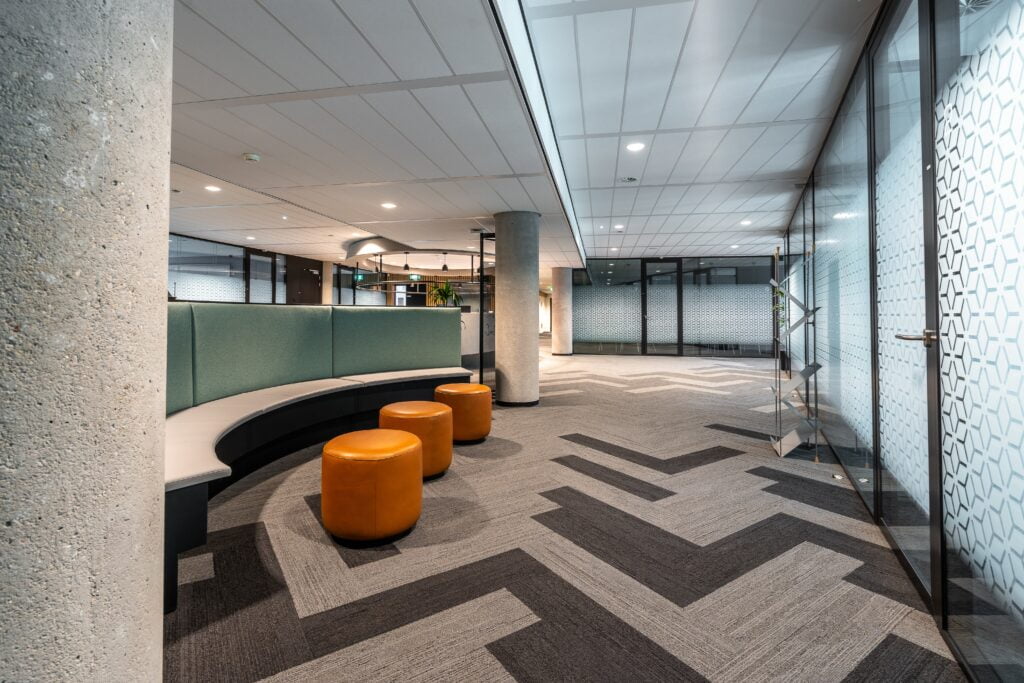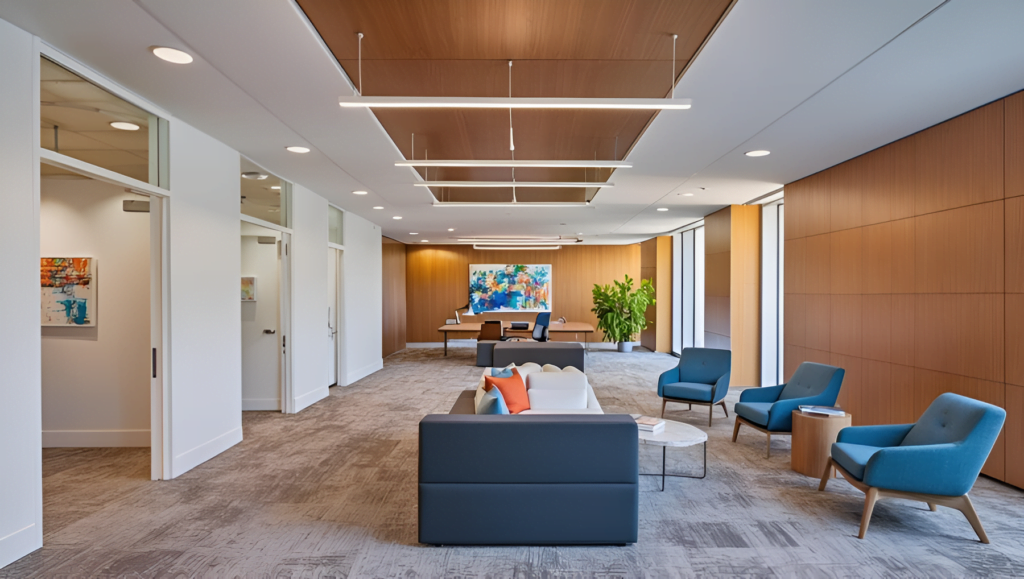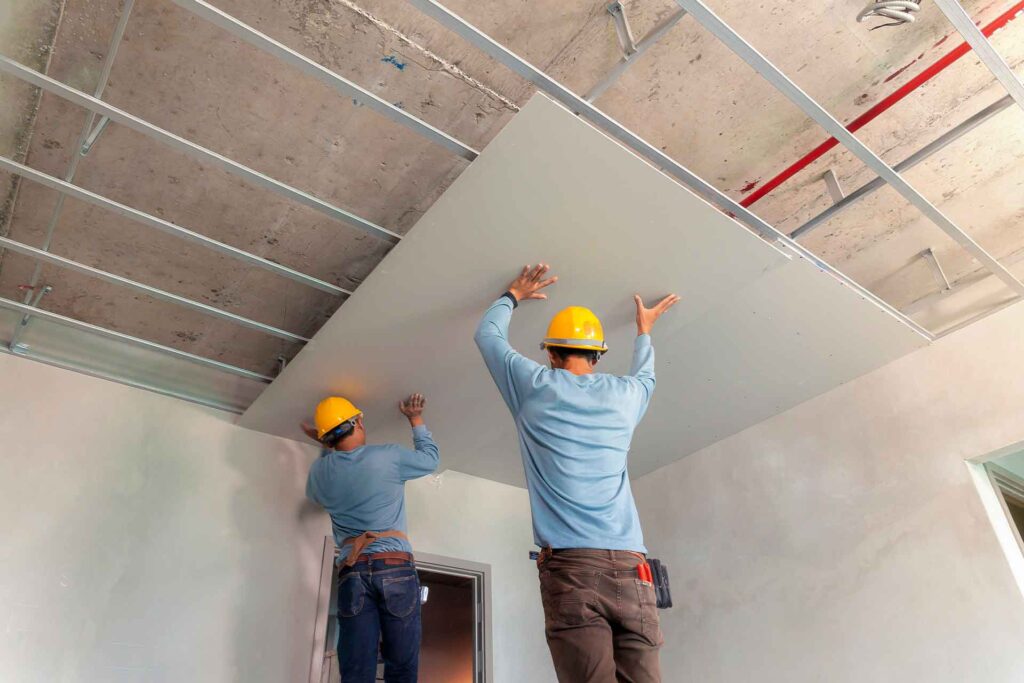In modern interior design, false ceilings have become a popular choice for both residential and commercial spaces. They not only enhance the aesthetic appeal of the office but also offer several functional benefits. In this comprehensive guide, we’ll explore what false ceilings are, their advantages, the different types available, and key considerations for installation.
What is a False Ceiling?

A false ceiling, also known as a dropped or suspended ceiling, is a secondary ceiling installed below the main structural ceiling. It is typically suspended by metal or wooden frames and can be made from various materials, including gypsum, plaster of Paris (POP), wood, metal, and PVC. False ceilings are used to hide unsightly elements like wiring, ductwork, and pipes while providing a smooth and attractive finish.
Benefits of False Ceilings
Following are the key benefits of false ceilings and how they can transform your interior spaces.
Aesthetic Appeal
It can transform the look of any room, adding a touch of elegance and sophistication. They allow for creative lighting solutions, including recessed lighting, cove lighting, and spotlights, which can enhance the overall ambience of a space.
Sound Insulation
It can significantly improve the acoustic properties of a room by reducing noise levels. This is particularly beneficial in offices, conference rooms, and home theatres where sound quality is essential.
Energy Efficiency
By creating an additional layer of insulation, false ceilings can help regulate indoor temperatures. This can lead to reduced heating and cooling costs, making the space more energy-efficient.
Concealing Imperfections
False ceilings are an excellent way to hide imperfections, such as cracks, stains, and uneven surfaces on the original ceiling. They also provide a neat solution for concealing electrical wiring, pipes, and ductwork.
Fire Safety
Certain materials used in false ceilings, like gypsum, are fire-resistant and can provide additional safety in case of a fire. This makes them a suitable choice for commercial buildings and residential spaces alike.
Types of False Ceilings
When designing an office space, selecting the right type of false ceiling is crucial for both aesthetics and functionality. Here are 10 popular types of false ceilings suitable for office environments:
- Grid Ceilings
- It features a metal grid framework with tiles or panels inserted into it.
- Benefits: Easy to install and maintain, allows for easy access to overhead systems (e.g., HVAC), and offers a variety of tile options.
- Uses: Commonly used in offices for its practicality and versatility.
- Gypsum Ceilings
- Description: Made from gypsum boards mounted on a metal frame.
- Benefits: Provides a smooth, seamless finish, can be shaped into various designs, and offers good acoustic and thermal insulation.
- Uses: Ideal for creating clean, professional looks in corporate offices.
- Mineral Fiber Ceilings
- Description: Composed of mineral fibers or acoustic tiles with sound-absorbing properties.
- Benefits: Excellent for noise reduction, provides a clean and uniform appearance, and is fire-resistant.
- Uses: Suitable for open-plan offices to manage sound and improve acoustic comfort.
- Acoustic Ceilings
- Description: Designed specifically for sound absorption, often made from materials like mineral fiber or foam.
- Benefits: Enhances sound quality, reduces noise levels, and improves overall office acoustics.
- Uses: Ideal for offices requiring quiet environments, such as conference rooms and open workspaces.
- Wooden Ceilings
- Description: Uses wooden panels or veneer to create a natural, warm look.
- Benefits: Adds elegance and a touch of sophistication, can be customized with different wood finishes.
- Uses: Best for high-end office spaces or executive suites where aesthetics play a key role.
- Glass Ceilings
- Description: Features glass panels or tiles installed as part of the ceiling design.
- Benefits: Allows natural light to flow through, creates a modern and sleek look, and can include tinted or frosted glass for privacy.
- Uses: Suitable for modern, stylish offices or areas requiring natural light.
- Metal Ceilings
- Description: Made from metal panels or tiles, often in aluminium or steel.
- Benefits: Durable, easy to clean, and offers a contemporary look. Metal ceilings can be perforated for acoustic benefits.
- Uses: Ideal for industrial-style offices or areas needing high durability.
- Stretch Ceilings
- Description: Features a flexible, stretchable material (often PVC or fabric) that is installed over a framework.
- Benefits: Offers a seamless, smooth finish, can be printed with designs or colors, and hides irregularities in the underlying structure.
- Uses: Great for modern, high-end office interiors and creative spaces.
- Modular Ceilings
- Description: Consists of modular panels or tiles that can be easily replaced or reconfigured.
- Benefits: Flexible and customizable, allows for easy maintenance and updates, and can incorporate various materials and designs.
- Uses: Ideal for dynamic office environments where layouts and designs may change frequently.
- Backlit Ceilings
- Description: Features a lighting system installed behind translucent panels, creating a glowing effect.
- Benefits: Enhances the visual appeal with ambient lighting, can create various color effects, and adds a modern touch.
- Uses: Suitable for lobbies, reception areas, or creative office spaces where lighting plays a key design role.
Modern False Ceiling Design Ideas for Offices

Here we have considered modern false ceiling designs tailored specifically for office environments, creating a workspace that is both stylish and highly functional.
1. Recessed Lighting Design
Incorporate recessed lighting into your false ceiling to create a sleek, modern look. Recessed lights provide even illumination and can be arranged in various patterns to highlight specific areas or features.
2. Coffered Ceiling
Coffered ceilings feature a grid of recessed panels that add depth and dimension. This classic design can be modernized with clean lines, contemporary colors, and integrated lighting.
3. Floating Ceiling Panels
Floating ceiling panels are suspended below the main ceiling, creating a layered effect. These panels can be used to define different zones within an open-plan office and can be enhanced with integrated lighting.
4. Linear Strips and Grids
Linear strip lighting and grid designs are highly popular in modern offices. These designs not only provide effective lighting but also contribute to a minimalist and futuristic look.
5. Cove Lighting
Cove lighting involves installing LED strips along the edges of a false ceiling to create a soft, indirect glow. This design is perfect for creating a cozy and inviting atmosphere in meeting rooms and executive offices.
6. Geometric Patterns
Geometric patterns, such as hexagons, triangles, or other shapes, can add a modern touch to your false ceiling. These designs create visual interest and can be used to highlight specific areas within the office.
7. Acoustic Baffles
Acoustic baffles are hanging panels that can be used in conjunction with a false ceiling to improve sound insulation. They are available in various shapes and colors, adding both functionality and aesthetic appeal to the office.
8. Perforated Metal Ceilings
Perforated metal ceilings combine durability with modern aesthetics. They also offer improved acoustics and can be customized with various perforation patterns to suit the office design.
Installation Considerations

1. Material Selection
Choose the right material based on the specific needs of your space. Consider factors such as moisture resistance, fire resistance, durability, and maintenance requirements.
2. Design and Layout
Plan the design and layout of the false ceiling carefully. Take into account the room’s dimensions, lighting requirements, and any other fixtures that need to be integrated into the ceiling.
3. Professional Installation
While some false ceiling materials are DIY-friendly, it’s often best to hire professionals for installation. They have the expertise and tools required to ensure a flawless finish and structural integrity.
4. Maintenance
Regular maintenance is essential to keep your false ceiling looking its best. Clean the surface periodically and address any signs of damage or wear promptly.
Conclusion
False ceilings offer a perfect blend of aesthetics and functionality, making them an excellent addition to any interior space. Whether you’re looking to enhance the visual appeal of your home or improve the acoustics and energy efficiency of your office, false ceilings provide a versatile solution. By understanding the different types of false ceilings and their benefits, you can make an informed decision that meets your design and practical needs.
Investing in a well-designed false ceiling can significantly elevate the overall look and feel of your space, making it more inviting and efficient. So, why wait? Explore the possibilities of false ceilings and transform your interiors today! Connect with us today


